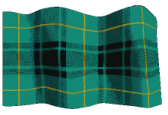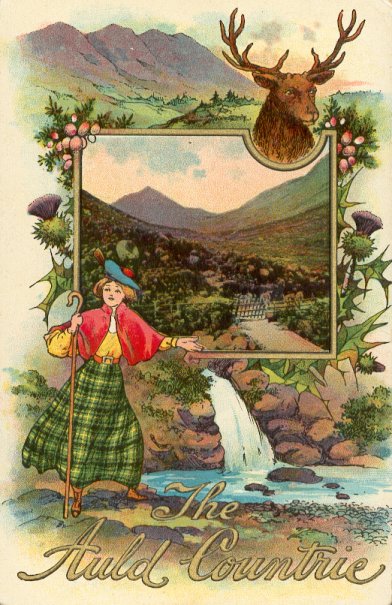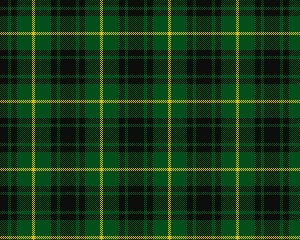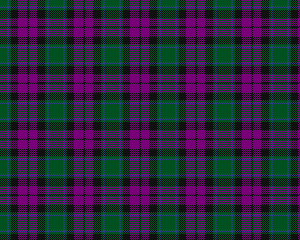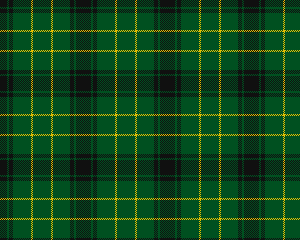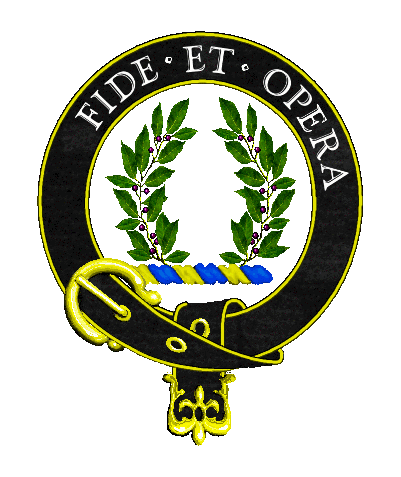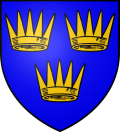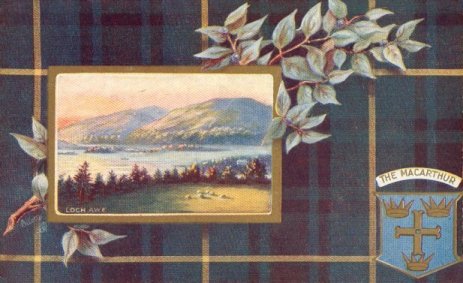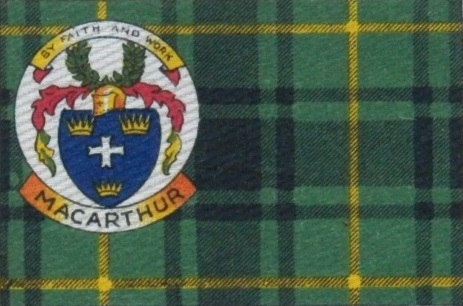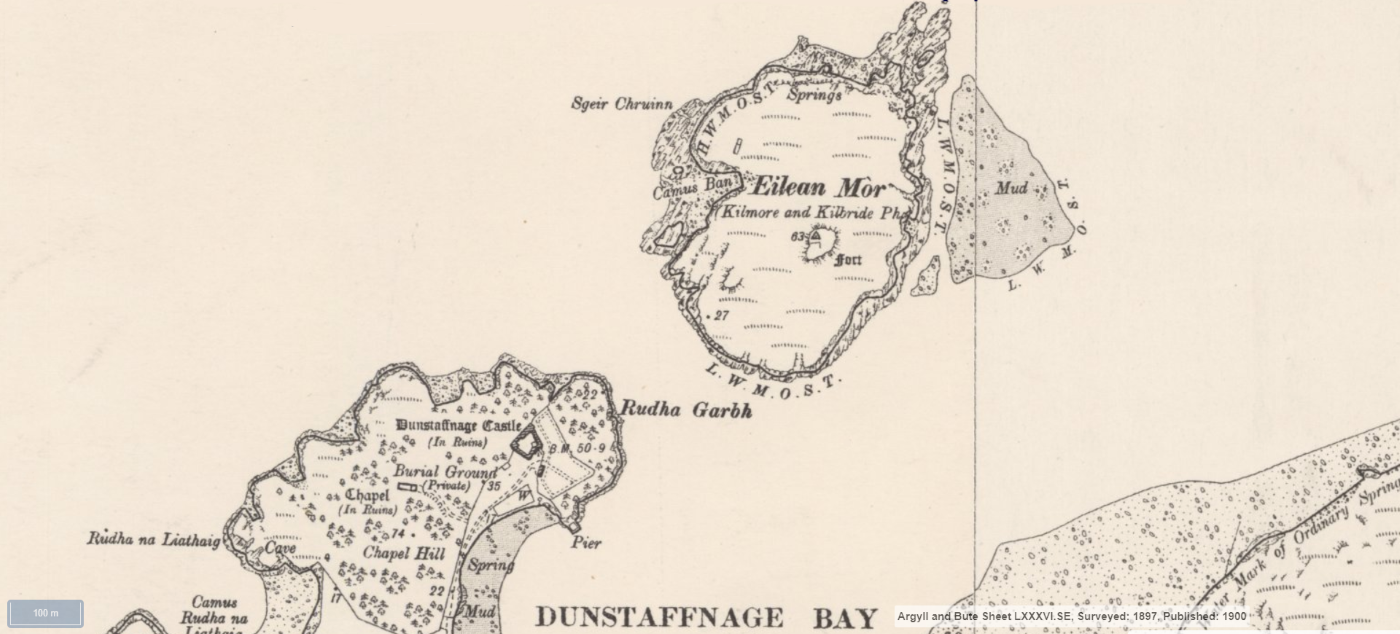Derivation of the Surname ARTHUR
The MacArthur Clan
The Auld Countrie
[modern sett with single yellow line]
The source of tartan 1100 was:
Vestiarium ScoticumMacArthur of Milton hunting Clan Tartan.
This is the older of the two MacArthur setts, which links the clan with the Campbells.
The source of tartan 700 was: Wilson's '1823' sample book.[old sett of 1816 with double yellow line]
The source of tartan 959 was:
Highland Society of LondonTartan: Though a Clan of Campbell stock, the MacArthurs also had links with the MacDonalds - the MacArthurs of Skye were hereditary pipers to the MacDonalds of the Isles - and their tartan has the same basic form as that of the Lord of the Isles. It also has similarities with the hunting version of the MacIver, who also lived in Campbell country. There is also an older MacArthur of Milton tartan whose design reflects the links with Clan Campbell.
(above) The Vestiarium Scoticum at page 85
Here followeth ye tertainis of ye lesser famylies or housis,
the quhilk (obsolete 'which') be cum frae ye chieff houses and oryginale clannes.
(above) Clan makArthour, The Vestiarium Scoticum at page 88
(above) The Vestiarium Scoticum at page 88
(explanatory note)
Crest Badge: Two laurel branches in orle, proper Slogan: Fide et Opera - By fidelity and work Chiefs and Chieftains: MacArthur of Tiracladich Gaelic: Mac-'ic-Artair Gaelic Name: MacArtuir (Son of Arthur) War Cry: Eisd! O'Eisd! - Listen! O Listen! Plant Badge: Wild myrtle (Gaelic: Roid); Fir club moss (Gaelic: Garbhag an t-sleibhe)
The current chief of Clan Arthur is John Alexander MacArthur who succeeded his father, James Edward Moir MacArthur of Milton (the first official chief of the clan in about 230 years), upon his death in 2004. The chief bears the undifferenced arms of the name MacArthur, and is the only person legally entitled to these arms under Scots law. The blazon of the chief's armorial shield is Azure, three antique crowns Or and corresponds to one of the attributed arms of the legendary King Arthur. Septs of the Scottish Clans
The name Sept is given to members of a Clan who do not share its name, although they may or may not be of the same blood. Clan Septs and dependents comprise those who were descended from the Chief through the female line and consequently bore a different surname; and those who sought and obtained the protection of the Clan and became dependents. Anyone who has an ancestor bearing a Sept name, or the Clan name itself, has the privilege of wearing or displaying the Crest Badge and the tartan of the Clan.
Within a Clan, following the Highland fashion of designating people by the names of their fathers, grandfathers, and sometimes more remote ancestors, other names could be used for certain family groups. Hence, in Clan Campbell there are the
- MacConochie ("Son of Duncan" in Gaelic) sept, descended from a Duncan Campbell
- early offshoots like the MacArthurs and the MacIvers who descend from the chiefly stock before the adoption of the name Campbell.
The word Clann in Gaelic means no more than "family" and there were hundreds of such groups who made no pretence to set up as major powers on their own but who followed the local chief and became members of his Clan.
Sometimes these smaller kindred were widely spread and their branches could follow different Chiefs. And very often the same name could come from a whole range of unrelated sources particularly in the case of Mac-names or patronymics, as they are called, which mean "Son of".
Septs of Clan MacArthur MacArthur clan tartan and coat of arms Arthur Arthurson Campbell Dewar MacArtair McArthure mcarthur Macarthur Makarturicht Maccaiter Makkerthrye M'Carthur Maccarter MacCarter M'Erthir M'Arthur Makarthure M'Carthair M'Artour M'Carthour McCarthair M'Artoure M'Arthor M'Arthour M'Carter M'Airthour M'Cairter M'Kartur McHarter McKerter MacArtur McKairtour M'Cairtter McAtur Makcairtour MacCartair MacCairter Mackartar MacArter McCartur Mcerter McArter M'Cartour Maccart McArtor M'Arthure mcArther Makarta M'Cartur mcArthour Magarta M'Arthur McArther Mecarta McArta mcArtor MacArta MacAtair McCartor Carter MacArtar mcArthor Cartter McAuthur McArtair Makarthour MacArther McArthur MacArtor McArther McArthur McCarter MacArthur Mcarthur McArthor McArthur Mcarthor MacArthor McArtour Mcartur MacIndeor
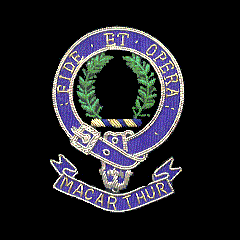
The legends of King Arthur are well known and historically contradictory. From the Welsh-speaking areas of Strathclyde (in which Glasgow now lies), Rheged and Gododdin (in which Edinburgh now lies), the earliest surviving Scottish poem tells of the resistance leader Arthur fighting against the English of Northumbria when they defeated Gododdin. When Scotland's Welsh-speaking Kingdoms were wiped out the language returned to Wales and Cornwall.
Arthurian legend was taken with it to be transplanted and developed all over these areas. Arthur's Seat, however, remains solidly beside Edinburgh. An ancient Celtic couplet ran, 'the hills and streams and MacAlpine but whence came forth MacArthur?' so old is the name.
The MacArthurs fought beside Robert the Bruce for Scotland's independence and gained mid-Argyll lands from the King's opposers as a reward. From here the MacArthurs prospered and spread, growing into two successful houses - the MacArthurs of Loch Awe and the MacArthur Campbells of Strachur.
In the thirteenth century a MacArthur married the heiress of Duncan mac Duibhne.
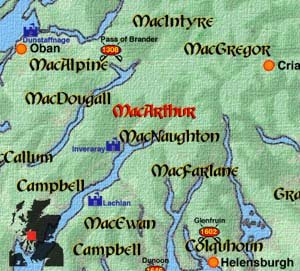
Later the Clanh Ua Duihne carried the nickname Cam beul. So through the MacArthurs came the Campbells.
When James I returned from his English imprisonment his wrath fell upon the MacArthurs among others. Through a wave of executions and estate seizures the MacArthurs were stunted and the Campbells became the predominant race north of Glasgow.
In 1567 Duncan MacArthur and his son, of the Loch Awe family, became the victims of their own success when jealousy drove neighbours to drown them in the loch.
A great number of MacArthurs emigrated from Scotland in the years following disastrous Culloden in 1746, choosing to restart in America, Canada, Australia and the West Indies.
A Clan of Campbell stock, the MacArthurs also had links with the MacDonalds - the MacArthurs of Skye were hereditary pipers to the MacDonalds of the Isles. Mythology has it that the MacArthurs are descended from the legendary King Arthur, that early British resistance fighter who may have fought the Scots and the Picts for his southern Scottish kingdom before his heroic exploits were recorded in the Welsh language.
But what certainly is true is that the MacArthurs are one of the most ancient Clans of Argyllshire, with lands on the shores of Loch Awe: Clann Artair na tir a chladich - Clan Arthur of the shore-land
Clan MacArthur had been seated so long at Loch Awe, that even in Celtic days the couplet was often said:
Cnuic 'is uillt 'is Ailpeinich, ach cuin a thaing Artairich ?
The hills and streams and MacAlpine - but whence came forth MacArthur ?Another ancient Gaelic couplet enforces their antiquity:
There is nothing older, unless the hills, McArthur and the devil The following has been extracted from The Scottish Nation by William Anderson, published in 1863 by A. Fullerton & Co (vol. ii. p. 709)
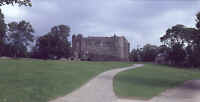
MacArthur (Gaelic Artair), a branch of the clan Campbell, which formerly inhabited the shores of Loch Awe, opposite the island of Inishail, and long disputed the chieftainship of the Campbells with the powerful family of Argyle. Mr. Skene, in his Highlanders of Scotland (vol. ii p. 282) says
"It is certain that until the reign of Robert the Bruce the Campbells did not possess an heritable right to any property in Argylshire. The situation of the MacArthur branch at this time was very different, for we find them in possession of a very extensive territory in the earldom of Garmoran, the original seat of the Campbells. It is, therefore, impossible to doubt that MacArthur was at this time at the head of the clan, and this position he appears to have maintained untill the reign of James I."
MacArthur adhered to the cause of Robert the Bruce, and received, as his reward, a considerable portion of the forfeited territory of MacDugall of Lorn, Bruce's great enemy. He obtained also the keeping of the castle of Dunstaffnage [188269,734475].
After the marriage of Sir Neil Campbell with the king's sister, the power and possessions of the Campbell branch rapidly increased, and in the reign of David II they appear to have first put forward their claims to the chieftainship, but were successfully resisted by MacArthur, who obtained a charter "Arthuro Campbell quod nulli subjicitur pro terris nisi regi."
In the reign of James I the chief's name was John MacArthur, and so great was his following that he could bring 1,000 men into the field. In 1427 that king, in a progress towards the north, held a parliament at Inverness, to which he summoned all the Highland chiefs, and among others who then felt his vengeance was John MacArthur, who was beheaded, and his whole lands forfeited. From that period the chieftainship is said to have been lost to the MacArthurs; the family subsequently obtained Strachur in Cowal and portions of Glenfalloch and Glendochart in Perthshire.
Many of the names of MacArthur are still found about Dunstaffnage, but they have long been merely tenants to the Campbells. The MacArthurs were hereditary pipers to the MacDonalds of the Isles, and the last of the race was piper to the Highland Society. He composed many pieces of bagpipe music which were highly esteemed by competent judges. A portrait of Archibald MacArthur, a native of the Island of Ulva (and who died after 1841), piper to Sir Reginald Macdonald Stewart Seton of Touch and Staffa, baronet, is in Kay's Edinburgh Portraits.
The Clan is thought to be an older branch of the Clan Campbell and to have held that chiefship in earlier centuries. But in 1427 Iain MacArthur, as one of the leading chiefs in Argyll, was executed by James I on his return from captivity in England and his lands forfeited, a disaster from which the Clan MacArthur never recovered.
The Lord Lyon, King of Arms, regulates Heraldry in Scotland. Sir Thomas of Learney, the Lord Lyon, published The Tartans of the Clans and Families of Scotland in 1938. By this time, the heraldry of the Scottish Chiefs was controlled by statute and a number of clan and family tartans became officially recognised in the Lyon's Court Book, and this was a useful way to "register" new clan tartans, though it was not a tartan register. Sir Thomas therefore encouraged incorporating The Scottish Tartans Society with the specific aim that a proper register be established.
Since the Lord Lyon maintains the Public Register or All Arms and Bearings in Scotland, authorised by parliament since 1592, then the new Register adopted a similar title The Register of All Publicly Known Tartans, though without any statutory authority. The Society's arms were granted to include three tenterhooks for hanging cloth and a woven diminutive based on the saltire.
"McIan's Costumes of the Clans of Scotland" (1899) James Logan from original sketches drawn by Robert Ronald McIan at pages 171 to 173
CLANN ARTAIR - THE MAC ARTHURS
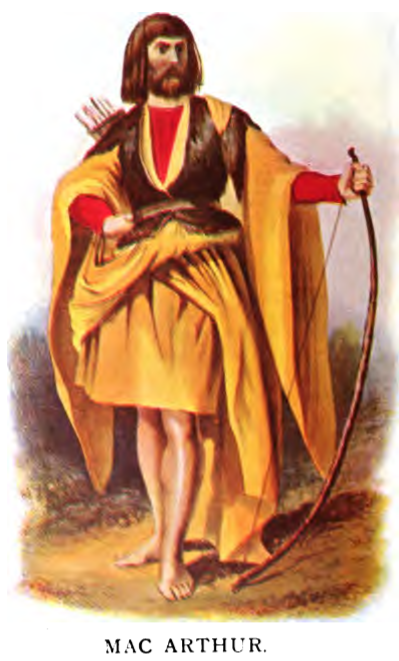
The condition of clans has, in many cases, fluctuated very considerably. Some originally of little note have attained an important position among their countrymen, whilst others, who at one time lorded it over extensive districts and a numerous people, have become reduced to a state of comparative obscurity, or have been finally merged in the race of their more powerful neighbours. Different circumstances operated to effect these changes; the more usual were the fortunes of war, and internal misunderstanding. The system of clanship was well suited to the preservation of a balance of power, or a degree of equality among the different tribes; but a continuation of feuds would weaken a clan and render it an easy prey to the ambitious.
It was the policy of the Scottish government, too weak to enforce its laws on a fiercely independent people, to engage one clan to subdue another by granting a commission of fire and sword, that is, a licence to attack the obnoxious party, slay them in the field, burn their houses, and harry their cattle - taking their lands as a reward for the service! The effect of such proceedings will be easily perceived: they account for the reverses in the circumstances of many clans.
The Mac Arthurs are a branch of the great Clan Campbell, and trace their descent from the original stock. They, indeed, long disputed the seniority with the powerful family of Argyle. In the reign of Alexander III, 1249 - 86, the Campbells presented two great divisions: those of Mac Chaillain mór and Mac Artair, and the latter maintained their right to the chiefship, and were, in fact, at the head of the clan; a position which they retained until the time of James I, who ascended the throne in the year 1406.
Mac Artair espoused the cause of Robert the Bruce, and was rewarded by ample gifts of the forfeited estates of Mac Dugal. The chief was also appointed captain of the castle of Dunstaffnsage, and the clan was in possession of such an extensive district as to rival that powerful house, which had so fearlessly opposed the royal champion of Scotland's independence.
John Mac Artair was beheaded by James I, and his lands were forfeited, since which time the Mac Chailain mór branch have held the chiefship, and gradually acquired the vast importance which they formerly held and still possess. The above John is described as being a great prince and leader of a thousand men.
In 1275, Cheristine, only daughter of Allan Mac Ruarai' granted a charter:
"Arthuro filio domini Arthuro Campbell militis de terris de Mudewarde, Ariseg et Mordower, et insulis de Egge et Rumme."
At subsequent periods the Mac Arthurs obtained Stra' chur in Cowal, from which they are designated, and they also held portions of Glenfalloch and Glendochart.
The Armorial Bearings appropriate to this clan must anciently have been that carried by the Campbells; but they have long borne insignia peculiar to themselves, viz, azure a cross moline, argent between three antique or eastern crowns, or. Crest, two laurel branches in orle, proper.
The SUAICHEANTAS, also, must have been the same as that borne by the Campbells.
Mac Arthur of Miltoun and Ascog bore different arms, which are quarterly; first and fourth azure, a cross moline between three antique crowns, or; second and third, or, a fesse checky azure, and argent within a bordure sable, charged with eight mascles of the third. Crest, a greyhound couchant, within two branches of bay tree, proper. Motto, "Fide et opera". The coat armour of the Mac Arthurs of England deviates very considerably from these, whence it would appear that they are not of the same race.
The seat of the Mac Arthurs of Stra' chur, is on the side of Loch Awe. Many of this name are still to be found about Dunstaffnage, who have long been merely tenants to the Campbells.
The figure wears the ancient yellow or saffron colour garment in which a former figure has been portrayed. This was the peculiar distinction of the Gaelic grandees, and, indeed, when it is considered that it was formed of linen, and contained twenty-four, or perhaps, thirty yards, it will be seen that it could not have been a common article of dress.
In a MS. History of the Gordons, preserved in the Library of the Advocates, at Edinburgh, there is a curious passage, which shows that it was well known as the dress of the Daoineuasal, or gentlemen in the north, in the end of the sixteenth century, about which time Martin, in his description of the western islands, 1698, says it had been laid aside:
"Angus, the son of Lauchlan Mackintosh, chief of the Clan Chattan, with a great party, attempts to surprise the castle of Ruthven, in Badenoch, belonging to Huntly (Earl of), in which there was but a small garrison; but finding this attempt could neither by force nor fraude have successe, he retires a little to consult how to compasse his intent. In the meantime one creeps out under the shelter of some olde ruins and levels, with his piece at one of the Clan Chattan, cloathed in a yellow war-coate, which among them is the badge of the chieftains or heads of clans, and piercing his bodie with a bullet, strikes him to the grounde; and retires with gladnes into the castle. The man killed was Angus himselfe, whom his people carrie away, and conceills his deathe for manie yeires, pretending he was gone beyond the seas. "
All trades and professions, by the rule of Celtic society, went from father to son and a long line of hereditary pipers to the Mac Donalds of the Isles were Mac Arthurs, of whom several amusing anecdotes are given in the interesting work on the piobaireachd music, by Mr. Angus Mac Kay, piper to her Most Gracious Majesty Queen Victoria. The last of the race, who composed many pieces highly esteemed by judges of these national melodies, died in London, having been long piper to the Highland Society.
